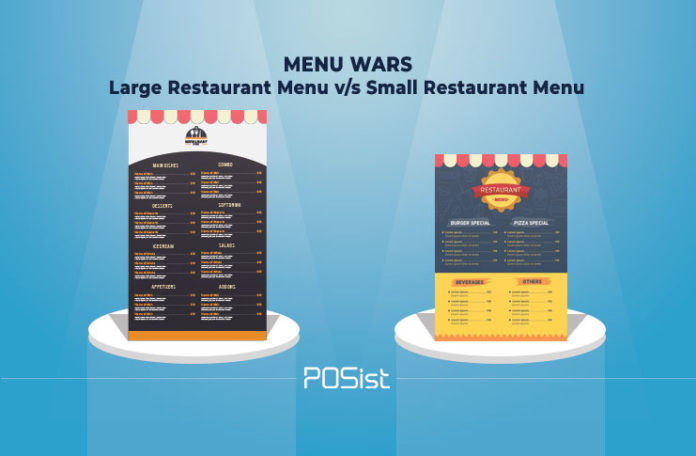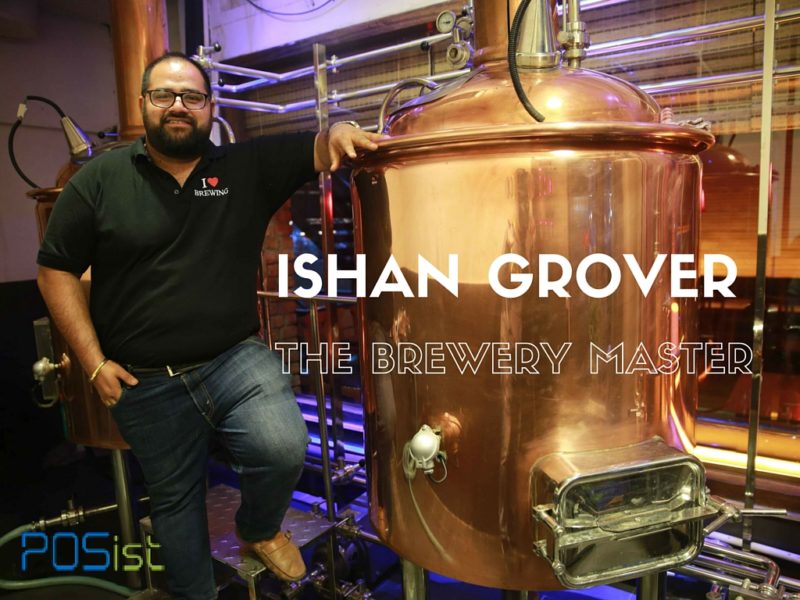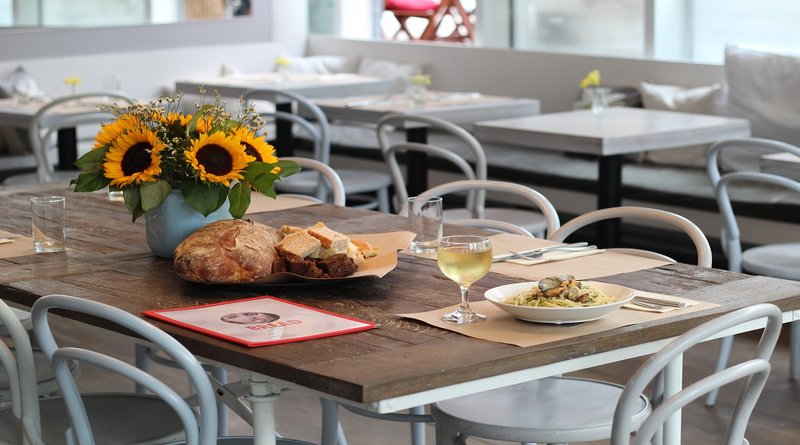Designing the restaurant menu is one of the fun parts of opening your restaurant. Whenever we talk of starting a restaurant, the menu, be it a digital menu or a traditional one is the first thing that comes to mind, and every restaurant owner has at least once given wings to the latent designer in them while finalizing the restaurant menu design. That being said, a key point of confusion while designing the menu is choosing the length.
The ideal length of the restaurant menu is a highly debated topic. Some experts say that simpler, smaller and shorter menus take the win, but at the same time, some benchmark restaurants like SilverBeach Cafe in Mumbai or The Cheesecake Factory boast of rather unconventionally long menus.
To make the decision easier for you, we have compiled a list of pros and cons of having a long and a short menu.
Big Restaurant Menu Or Small Restaurant Menu: Which Is Better For Your Business?
Pick any menu design guide, and the first thing that you will read is that your restaurant menu must be short and concise. At the same time, take a practical look through menus of giants like Domino’s, Pizza Hut, and Mc Donald’s or benchmark restaurants like Cafe Delhi Heights or Big Chill, and the first thing that you will see are varieties of dishes on a seemingly never-ending menu.
It is this dichotomy which often confuses new restaurant owners. You must have asked yourself more than once, “What is better?” While we can not answer the question for you, we have compared some advantages and disadvantages of both the formats to make your decision-making process easier.
Pros Of A Big Restaurant Menu
Let’s begin with large restaurant menus. Here are the top advantages of having a long restaurant menu –
1. Have A Bit For Every Taste
A direct perk of having a large menu is that you can accommodate more variety of dishes. This will enable you to serve various taste buds within your target audience and even aim for a broader audience. By going for a longer menu, you will have the freedom and flexibility to keep a little bit of everything and create dishes for every mood. For example, you can have sandwiches, burgers, and pizzas at one end and tacos at the other. At the same time, you can also serve comfort foods like hot chocolate and beverages like Mojito or Cosmopolitan at your restaurant.
Hence, your target audience base will increase, and your customers will have a wider variety to choose from, which will also give you a competitive edge.
2. Experiment Safely
When you have a large menu and vast menu offerings, you can experiment with your dishes and flavours without worrying too much regarding the restaurant profitability. You can have a separate column by the name of ‘Chef’s Specials’ or ‘House Specials’ for your custom creations. Because your other menu items will be selected to earn profits, you can have an extra column to sell what you want to sell. The best part, with a longer menu you do not have to worry regarding the acceptability of these dishes since you can earn a profit through your other menu items.
3. Leave Them Hanging For More
If your food is great, one of the biggest perks of having a long menu is that it will act as a tool for customer retention. Your customers will love to come back for more, especially if they know that there are other delicious menu items which you serve. This curiosity will keep them hooked to your restaurant all because you serve a variety of dishes which they would love to try.
Cons Of A Long Restaurant Menu
Nothing in the world exists with just a positive side. The main disadvantages of having a long restaurant menu are:-
1. Not Customer-Friendly
A fun fact regarding menus, customers spend an average of 109 seconds looking at the menu before deciding what to eat. This is the window you have to sell your most profitable dish to your customers. Doing so is very hard when there are too many options. The basic psychological result is that the customers automatically default to the safest option.
The problem is that the safest options are the most basic things on a menu which mostly taste well in any establishment. Two things happen because of this:-
- You may not earn a reasonable profit from the customer
- The customer categorizes you as any restaurant without a unique identity; thus you fail to create a recall value. Without a recall value, customer retention becomes a more difficult process.
- Serving a large variety of dishes that are prepared fresh can be extremely cumbersome, especially if the footfall at your restaurant isn’t too high. Your customers may be sceptical of eating if you have dozens of items in your menu thinking them to be stale.
2. Menu Optimization Becomes A Tiresome Process
Optimizing the menu is an essential restaurant operation. It includes studying which dishes work well, which do not, which need to be used for marketing, and which to scrape off. When you have a long menu, with a variety of dishes, studying every dish becomes a tiresome and time taking process. At the same time, studying patterns and selecting dishes to optimize your marketing strategies also get complicated because there are too many menu items to consider and too many factors revolving each item to consider.
Thus, optimizing the menu becomes a complicated process, and the restaurant operation in itself becomes less efficient and more susceptible to loopholes and errors. Under extreme circumstances, this may result in loss of customers and huge losses for the restaurant.
3. More Offerings Means More Inventory Load
When you have a large number of dishes on the menu, it also means that you have a huge stock of inventory in your storage facility. This makes the already time taking process of inventory management even more taxing, thus increasing your staff requirement. At the same time, with the variety and quantity of stock, it becomes easier for your staff to steal from you, hence increasing your costs and losses. Moreover, some dishes always run the risk of not being ordered enough.
In a longer menu, this risk increases but you must still stock yourself with a sufficient amount of raw materials for these dishes. In case a dish performs badly, the inventory will not move. Given the fact that inventory here is food which is perishable or prone to spoilage and damage, it increases your risk and cost.
4. Big Menus Impact The Table Turnover
If you have a large restaurant menu with a lot of items, your customers would take a longer time to go through all the items to decide what to order.
Also, it would take more time to prepare the order in the kitchen as well. More menu items mean that your kitchen staff would be preparing different items when they could be preparing the same item that could be served to the guests. Not only does this hampers the customer experience, but it also impacts your table turnaround time significantly, as it would take longer for you to serve the guests
Now that we have given you our comparison regarding long food menus in restaurants, it is time to focus your attention on the much advised small restaurant menus.
Pros Of Having A Small Restaurant Menu
Most menu engineers endorse small menus for food outlets. This especially stands true for new restaurants which have just entered the industry. Here we have for you the top 3 advantages of having a small food menu at your restaurant.
1. Customer-Friendly
Smaller menus are more customer-friendly. Customers can easily look through the menu and decide what they want to order without much hassle. They save time when the customer is in a rush and make the entire decision-making process easier. This customer-friendly nature of smaller menus adds greatly to customer satisfaction.
2. Easy To Engineer, Design and Optimize
Smaller menus are easier to work with. Hence it makes engineering these menus for profitability and optimizing them in future easier. Smaller menus have fewer offerings which make setting the most profitable dishes in the best menu spots possible. At the same time, the designer can create a high profit yet appealing menu through the use of graphics, pictures or highlights. Setting decoys also become easier, and the overall menu works to boost restaurant profits.
Fewer dishes are easier to optimize as well. Individual factors impacting each dish may be many, but with a less amount of dishes, say five, you do not need to consider many factors while making menu decisions. Hence it is easier to strategize your upselling techniques and marketing campaigns. Understanding the individual sales of each dish and comparing performance patterns also takes a lesser amount of time, thus making the process of optimizing the menu relatively easy and less prone to errors.
3. Does Not Load The Inventory Management Process
One of the biggest perks of offering a limited number of dishes is that managing inventory gets easier. With a small number of dishes, less raw materials are required. Managing fewer ingredients is far easier than managing huge quantities, the risk of mismanagement, wastage, and internal theft is greatly reduced, and you do not need to hire more staff to manage a humongous amount of inventory.
Cons Of Having A Small Restaurant Menu
Even though a small restaurant menu sounds like a designer’s and a restaurant owner’s dream, it comes with its share of negatives as well. Here are the main disadvantages of a small restaurant menu –
1. Cannot Tap A Varied Audience
Unlike its longer counterpart, a smaller menu will have more specific dishes, targeted towards the target audience. You will not be able to tap into a broader consumer base due to the limited amount and nature of your dishes. At the same time, even your target audience may not come to you all the time as it is not necessary that your menu will cater to their every mood. Hence, you lose some potential customers and sales from your target customers due to lack of diversity in your menu.
2. Can Accommodate Limited Items
A small menu will have limited items. The problem with this is that even in a selected cuisine, you will not be able to experiment a lot. This is because basic strategy calls for you to keep some safe and default items for the customers, like Arrabiata and Alfredo Pasta, Pizzas, or garlic bread. These are the item that the customers can order anytime without worrying about the taste as they are conventionally good at every restaurant. The drawback of a small menu is that because you must have these items for customer satisfaction, hardly any scope of serving anything else is left. Due to this, neither are you able to serve all of your specials or your creations, nor are you able to create a recall value in the minds of the customers.
3. Easy To Get Tired Of
As said earlier, small menus don’t host much variety. The immediate drawback of this is that customers can easily get bored of the dishes being offered and move to a more diverse competitor. If your menu does not excite the customers, or if you fail to add value and diversity to it from time to time, your customers will get tired of the same dishes sooner or later and opt to dine at another restaurant.
Designing a restaurant menu requires a lot of thought and practical decision-making. Every element needs to be put at a particular place for increased profitability. Even if you master the design of the menu, if you choose the incorrect length or categorization all your effort can go to waste. Consider both the pros and cons of long and small menu sizes before choosing an ideal length for your restaurant menu.
Whether you decide to go ahead with a big restaurant menu or small, here’s a Restaurant Menu Engineering Checklist that will help you create the perfect menu for your restaurant.



















It doesn’t take long for many new restaurateurs to realize that an overly large menu includes an excessive amount of prep time, the bigger chance of food spoilage and they ultimately cost more money than a smaller, more streamlined menu. The article above is very well written, explanatory and comprehensive. Good Work Restaurant Times.
While a long menu definitely does offer a very wide variety, a short or small menu need not be constrained by range offered. We can smartly switch to alternating short menus for different days or week, or change the menu once a week, depending on the target audience in mind. So a short menu could also bring in customer loyalty due to variance across a time frame.
Great post. Enjoyed reading it over.
This is such a fantastic, detailed list!
And how you’ve categorized it makes it so easy to find what you need- great idea!
Thanks for post this article. it’s a great thing to share with us. I think a small restaurant menu will be the winner.
I think a win by a small menu restaurant. thanks for sharing this post.
I think this not a small, not a big type. just like a medium type or well designed.